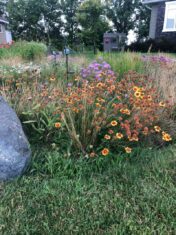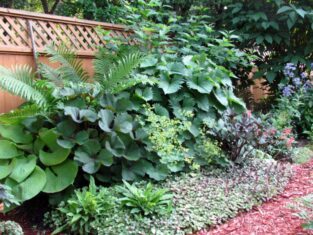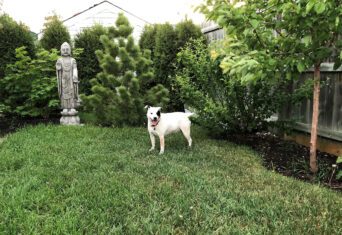
The genus Rhododendron is a huge one with more than 1,000 species and about 28,000 cultivars, but for the majority of Canadians most of these beautiful shrubs are out of reach, due to their lack of cold hardiness and preference for acidic soils. But thanks to the breeding efforts of hybridists in Massachusetts, Minnesota and Finland, even gardeners in Zone 3 can enjoy these vivid springtime blooms by planting cultivars that are designed to withstand our frigid winter conditions.
Only gardeners distinguish between rhododendrons and azaleas — to botanists, they’re all rhododendrons — and in spite of numerous exceptions, by tradition rhododendrons have evergreen leaves and bear flowers with 10 stamens, while azaleas have five stamens and tend to be deciduous. Most cultivars like to be sited in part-shade (or “dappled” shade); leaves often scorch in full sun, and dense shade can result in fewer flowers.
Possibly the most widely grown rhodo in the world — and always the first to flower in my garden — is lavender-pink ‘P.J.M.’ (R. [PJM Group] ‘P.J.M.’). The original cultivar was hybridized at Weston Nurseries, about 50 kilometres northwest of Boston, Massachusetts. Weston Nurseries was founded in 1923 by Latvian immigrant Peter John Mezitt (1885-1968), and ‘P.J.M.’ is the result of the very first rhododendron crosses made by his 24-year-old son Edmund — talk about beginner’s luck! But that was in the summer of 1939, and as ornamentals were moved to “the back 40” to make way for vegetable production during the Second World War, the young rhododendron seedlings were all but forgotten.
Edmund V. Mezitt (1915-86) later recalled a sunny Sunday afternoon toward the end of the war in May, 1945: “My heart still skips a beat when I remember the reaction of our entire family when we saw that ribbon of brilliant pink running across the hill. We named it ‘P.J.M.’ [his father’s initials] right on the spot.”
The result of a cross between the small-leaved Piedmont rhododendron (R. minus var. minus [Carolinianum Group]) and from Siberia, the Dahurian rhodo (R. dauricum [Sempervirens Group]), ‘P.J.M.’ grows about five feet (1.5 m) tall and wide. Hardy to Zone 3, it bears striking magenta-pink flowers above evergreen foliage, and due to its carefree nature, it’s an excellent choice for rhodo newbies.
Following the introduction of ‘P.J.M.’, other plant hybridizers were keen to jump on the hardy rhododendron bandwagon, and in 1957 Albert G. Johnson began a breeding program at the University of Minnesota that would eventually flower into the Northern Lights Series. After Johnson’s death, the program was expanded by Harold Melvin Pellett (1938-2014), and the first Northern Lights cultivars were introduced in 1978. Since then, 15 cultivars have been released, all of them hardy to at least -30°C.
Look for the deciduous azalea ‘Northern Lights’; it produces trusses of up to 12 fragrant pink flowers on leafless stems, and grows about five feet (1.5 m) tall and wide. Hardy to -40°C, it’s derived from a cross between Mollis hybrids (R. ×kosteranum, Belgium 1870s) and our native alkaline-tolerant roseshell azalea (R. prinophyllum).
Another one of my favourites is ‘Mandarin Lights’, a cross between the roseshell azalea and R. ‘Exbury White’ (England, 1920s) which produces fragrant, bright orange flowers and is hardy to -34°C. I scandalized my neighbours by surrounding it with dark purple ‘Negrita’ Triumph tulips. Daring gardeners eager to pull a similar taste-defying stunt should note that rhododendrons have fine, fibrous roots that lie close to the soil surface, so to avoid root damage, complementary — or contrasting! — bulbs should be planted at the same time the rhodos are. Mulch with (in order of preference) pine needles, shredded oak leaves or bark chips to help keep the root run cool and conserve soil moisture.
Meanwhile, across the pond in Finland, a young plant hybridizer named Marjetta Uosukainen initiated a rhododendron breeding program in 1973 at Helsinki University using the Asian R. brachycarpum for cold tolerance. By the time she retired in 2014, Marjatta had introduced a dozen large-leaved cultivars that are now known as the Marjatta (or Finnish) Hybrids.
Look for ‘Helsinki University’ which grows six feet (1.8 m) tall and wide, and bears pink flowers with orange-red flecks that are held above glossy evergreen foliage. Likely the toughest large-leaved rhodo in commerce, it’s hardy to -40°C.
Although PJM Group and Northern Lights Series cultivars are tolerant of slightly alkaline soils, all rhododendrons prefer acidic soils in the range of pH 4.5 to 5.5 (pH 7.0 is neutral). Elemental sulphur pellets and iron-rich, soil-acidifying rhodo fertilizers will help, but where soils are strongly alkaline, I would suggest growing rhodos in raised beds or large containers.









I live in Ottawa, Canada. I have had very good success with the northern lites series of azaleas. I have about 20 and some are 6 feet tall. Over the winter, I wrap with burlap. Yes, that is a lot of burlap!! I have tried PJM rhodos a few times but with little success. They survive the winter but the buds which set in the fall do not flower.
I am in Ottawa and have been winter protecting my older PJM Rhodo for the last 15 years. It is doing well. I just purchased a Nova Zembla this year. It says Nursery Pepiniere. Also good to -29. Would it be a Helsinki variety or Northern lights variety? It is just about to open but the tag states red flowers with black freckles. 6-8′ tall and wide.
I live in British Columbia in a zone 3-4 and would love to grow Rhododendrons.
We have deer but due to the forest have great acid soil base.
Any suggestions
i have had a few pjm rhodos but they seem to get a wilt or something what should i do
I live in New Harbour, Newfoundland where we have a maritime climate and acid soils so rhodos are easy to grow. I have 6 in my garden from a diminutive miniature single purple just 8 inches tall to a massive 30 year old pink rhodo 12 feet high along with smaller white and red rhodos. I also have a rhodo that started in my father-in-laws garden, moved to my sister-in-laws and subsequently here to my garden. It is at least 50 years old and shows no sign of stopping, covered in masses of pale pink blooms every year.
I have two PJM’s that are getting crowded out by the larger varieties around them. I would like to move them and could use some advice. Thanks, Barbara
Hello Barbara,
If at all possible, I would recommend waiting until autumn to transplant your PJMs, when the shrubs will be entering their semi-dormant stage.
If you *must* transplant them now, dig a very large rootball to avoid damaging the surface feeder roots while the plants are in active growth. Keep plants well-watered (and mulched!) during the heat of summer, and suspend using any fertilizers for the rest of this year–plants that are undergoing summertime transplant shock should never be fed. Of course, some good, gentle compost or composted manure added to the planting holes would be fine. Good luck, and let us know how you get on. Best, Stephen
I live in Winnipeg. I have a PJM rhodo that is at least 30 years old. I purchased it as a very small plant shortly after I moved into my house in 1984 and it has been going strong ever since. It set a huge number of flower buds last year, but due to the very warm early spring and hardly any rainfall this year, all of the buds aborted. Not the plant’s fault. It much prefers our cool springs with more than adequate moisture. I miss the flowers….
Thirty-plus years old–especially in Winnipeg–is fantastic. It just shows how dependably cold hardy the PJMs are. Incidentally, some PJM strains apparently have a biennial flowering habit: one year on, one year off–much like unpruned apples. I’d love to see the base of your shrub–it must look like a tree trunk at this stage?! Congrats 🙂
If I knew how to post the picture, I would.
I have PJM Rodos in bloom right now. They have been in the same spot for about 3 yrs, did not do too well. This is the first time they are in bloom. They are about 24 in tall.
My question is – can I move them and if so, when is the best time to move them.
Please e-mail me an answer.
Thanks
Hello Irene,
The best time to move PJMs is when they’re semi-dormant, i.e., mid-autumn or late winter. If you plan to move them in late winter, it’s a good idea to dig and prepare the new planting holes before autumn freeze-up so that you can just pop them in.
If the new spot has dappled shade (or only morning sun, that is, an eastern exposure) and rich, slightly acidic soil, you should notice a fast turnaround in both their vigour and flowering. Best of luck!
love both rhodos and azaleas. Actually have quite a few here in Nova Scotia. My favourite are the yellow/orange ones, with Manderin Orange being my favourite. About 12 on my front garden, and just added another 10 in the past two years to other sides of our property. Years ago, someone gave me a P.J.M. and I stuck it in the back swamp/yard. Then about three years ago, I discovered it, and moved it to my front garden with all my yellow/orange ones. It is in full bloom now, quite large, and beautiful. My others in this plot, are just in bud stage, and two yellow rhodos also in bud stage. I grow tons of tulips also, so I liked your tip about purple tulips with the orange azaleas! Most informative article, thank you.
Your garden sounds amazing–and large! Glad that you like Mandarin Lights as much as I do (some gardeners might consider it an acquired taste 😉 ) Maybe it’s genetic–there are several Mosers in my NS family tree.
I planted 3 young Rhodos 3 years ago, every spring I have observed buds that look very promising, yet I have been disappointed as very new leaves emerge instead of the promised and anticipated flowers. I have put rhododendron fertilizer all around the base. What gives? Any ideas? My old Rhodo never disappoints however
Thank you for this and your many informative articles
Hi Jeanne,
When buds abort on otherwise healthy plants, it’s usually due to weather conditions. Have you experienced late spring frosts? Another possibility is that they are planted in a location with a south or south-west exposure: Southern exposures often coax flower buds into early maturity, and then a late cold-snap will cause them to freeze and abort. If this is the case, I would recommend moving them to a site with an eastern or northern exposure. Hope that helps– Good luck, Stephen